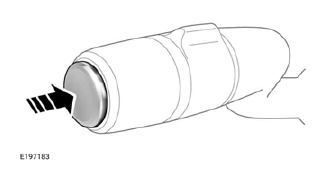Land Rover Defender: Trip computer
The trip computer displays and stores trip information. The information panel displays the information.
The following information can be displayed:
- Date.
- Trip distance.
- Average speed.
- Average economy.
- Instantaneous economy.
- Range.

Press and release the trip button, located on the end of the lighting control, to scroll through the available options.
Some trip computer information can be reset to zero. Press and hold the trip button for 2 seconds, when the instrument panel displays the required information.
Two trip computers are available: Trip A and Trip B. Both display the same information. To switch between the trip computers:
1. Select the Trip instrument panel menu.
2. Select Trip bank.
3. Select Trip A or Trip B.
A third option, Trip Auto, is also available.
Trip Auto allows the driver to add or remove data from either Trip A or Trip B to a running total.
To add data for the last journey to Trip Auto:
1. Select Trip Auto from the Trip bank menu.
2. Press the trip button for longer than 1 second.
3. The instrument panel displays either Adding last journey or Removing last journey. Press the trip button for longer than 1 second to select the desired option.
The trip computer can be configured to display in miles or km in the same way as the speedometer.
HEAD-UP DISPLAY (HUD)

Do not operate or adjust the Head-Up Display (HUD) while the vehicle is moving. Doing so may cause driver distraction. Driver distraction may cause an accident, leading to serious injury or death.
The HUD projects some instrument panel information onto the windshield.
Note: The HUD must be correctly adjusted to match the driver before use.
To switch the HUD on or off:
1. Select the Head-up display instrument panel menu. 2. Select Enable HUD.
To select which items the HUD displays:
1. Select the Head-up display instrument panel menu.
2. Select HUD content.
3. Select the options to be displayed from the list.
Note: The HUD can only display information that is also currently displayed in the instrument panel.
Note: The position and format of the displayed information is dependent on the priority and number of options selected.
If the HUD requires cleaning, follow the recommended procedure.
ADJUSTING THE HEAD-UP DISPLAY (HUD)

Do not operate or adjust the Head-Up Display (HUD) while the vehicle is moving. Doing so may cause driver distraction. Driver distraction may cause an accident, leading to serious injury or death.
The position and brightness of the HUD can be adjusted. The position of the HUD must be correctly set before use. The correct position is dependent on the height of the driver and the seat position.
To set the HUD to the correct position:
1. Set the driver's seat to the correct position.
2. Select the Head-up display instrument panel menu.
3. Select Position.
4. Follow the on-screen positioning instructions, using the arrow icons on the left-side steering wheel controls.
5. When correctly adjusted, press the O icon on the left-side steering wheel controls.
The position of the HUD can be stored using the seat memory function.
To adjust the brightness of the HUD:
1. Select the Head-up display instrument panel menu.
2. Select Brightness.
3. Follow the on-screen instructions, using the arrow icons.
4. When correctly adjusted, press the O icon.
HEAD-UP DISPLAY (HUD) LIMITATIONS
The Head-Up Display (HUD):
- Takes longer to display information in extreme temperatures.
- Does not operate correctly if items are placed between the top of the dashboard and the windshield.
- May not view correctly if the driver is wearing polarized sunglasses.

